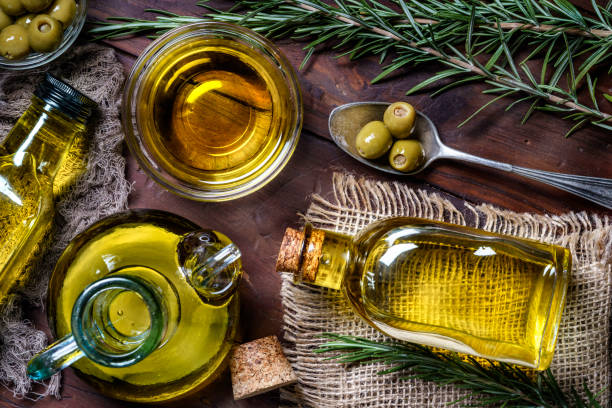Farmed GMO vs. Wild Non‑GMO Olive Oil: Understanding the Clear Distinctions
Introduction
Olive oil has long been championed for its flavor and health benefits. But what happens when non‑GMO wild-harvested oils are compared to hypothetical GMO or industrial farmed olive oils? While GMO olives aren’t commercially widespread yet, exploring the theoretical differences helps us appreciate why wild, non‑GMO olive oil remains superior in purity, flavor, environment, and nutrition.
Section 1: Theoretical Background on GMO Olives
No GMO olives currently in mainstream cultivation, but biotechnological research continues.
A “farmed GMO” olive could involve traits like drought resistance or pest resistance—but may compromise nutrient density and ecosystem diversity.
In contrast, wild olives grow naturally, without chemical treatments or genetic modification.
Section 2: Cultivation & Harvesting
Farmed GMO or Industrial Orchards
Grown in monoculture plantations.
Mechanization, irrigation, synthetic fertilizers, pesticides.
Harvest from standard cultivars, often with mechanical shakers.
Wild Non‑GMO Groves
Untouched hillside or forest olive growth.
No irrigation, pesticides, or herbicides.
Hand-harvested, often selectively at peak ripeness.
Section 3: Nutrient & Antioxidant Profiles
Farmed, genetically modified trees may yield higher quantity but lower nutrient density due to accelerated breeding.
Wild olives, stressed by environment, produce greater concentrations of phenolics, polyphenols, and antioxidants—critical for flavor and health.
Section 4: Extraction & Processing
Industrial / Commodity Olive Oil
Often refined or blended of multiple sources.
Extraction methods may include heat or even chemical refining.
Lacks clear harvest dates and transparency.
Wild Non‑GMO Olive Oil
Cold-pressed, unrefined, minimally filtered or unfiltered.
Traceable from a single grove or small batch.
Harvest-to-press within 24 hours to maintain freshness.
Section 5: Flavor and Sensory Experience
Farmed/industrial oils may appear bland or overly smooth; may be deodorized.
Wild olive oils, rich in polyphenols, carry bold peppery, grassy, herbaceous notes. They can induce a throat sting—a sign of oleocanthal.
Section 6: Health Implications
Wild non‑GMO oils: higher in antioxidants, anti-inflammatory nutrients, vitamins, and beneficial fatty acids. Stronger evidence for improved heart, brain, metabolic, joint, and digestive health.
Hypothetical GMO-derived oils: might offer yield benefits but are unlikely to match wild oils in health markers unless processed identically.
Section 7: Environmental & Ethical Dimensions
GMO farming often correlates with industrial agriculture, reduction in biodiversity, chemical runoff, soil degradation.
Wild harvesting promotes ecosystems, preserves native plants, supports small rural communities, and bolsters regenerative traditions.
Section 8: Labeling, Certifications & Consumer Trust
Certified Non‑GMO Verified, Organic, or PDO/PGI status helps assure origin—especially for wild olive oils.
Industrial oils may offer quantity labels but often lack back-traceability and test results for acidity or phenolic content.
Section 9: Consumer Perspective Comparison
| Feature | Farmed GMO / Industrial Olive Oil | Wild Non‑GMO Olive Oil |
|---|---|---|
| Cultivation | Monoculture, pesticides | Wild groves, no chemical inputs |
| Genetic manipulation | Possible future GMO traits | Traditional natural cultivar |
| Harvesting | Mechanical, mass harvesting | Hand-picked, selective, artisanal |
| Yield | High | Low, value-driven |
| Nutrient density | Moderate to low | Very high (polyphenols, antioxidants) |
| Extraction | Possible heat/chemical refining | Cold-pressed, minimal intervention |
| Flavor profile | Mild or bland | Robust, peppery, herbal |
| Environmental impact | Higher resource use, ecological strain | Biodiverse, low-impact, sustainable |
| Transparency & traceability | Limited | Full traceability, batch testing |
| Price & rarity | Lower cost, widely available | Premium pricing, gourmet, limited batch |
Section 10: Why Wild Non‑GMO Reigns Supreme
Flavor & Health: High phenolic content = superior antioxidant and anti‑inflammatory benefits.
Integrity & Trust: Full traceability, small-batch production, no compromising refining.
Ecological Respect: Wild harvesting protects biodiversity, traditional land, and heritage.
Holistic Value: Supports quality over yield, and nutrient density over industrial scale.
Section 11: Tips for Choosing Well
Seek oils labeled “Wild Harvested”, “Cold‑Pressed”, and “Non-GMO Certified”.
Prefer unfiltered or lightly filtered oils for maximum nutrient retention.
Always check harvest dates—fresher means more potent.
Perform sensory tests: a green aroma, bitter-peppery throat bite, and grassy finish indicate active polyphenols.
Section 12: Using Each Oil Type
Farmed rich oils (if GMO were available) may serve routine high-heat cooking but lack distinct flavor and nutrition.
Wild non‑GMO oils shine in raw applications, drizzling, finishing dishes, morning rituals, DIY skincare, and herbal infusions.
Conclusion
While industrial or future GMO-produced olive oils might aim for efficiency, they fall short on the depth of flavor, nutrient density, environmental consciousness, and cultural heritage. Wild non‑GMO olive oil stands as a testament to purity—each bottle encapsulates tradition, health, and integrity. Choose it for a richer culinary, nutritional, and ethical experience.




